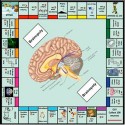I am a big proponent that learning should be fun. After all, learning should be reinforcing rather than aversive, making the students want to learn more. Recently, there has been a great amount of research in using games (video games, board games, and computer games) in the classroom to facilitate learning.
Most research studies suggest that using game-based learning (GBL) not only makes the students more interested in the material, but also helps with retention of the learned material, test performance, participation and engagement, and integration of the material, among other benefits. Furthermore, GBL allows for simulation of the learned material, allowing for practice and mastery.
Most of the GBL studies were run using children and adolescents. What about adults? Several recent studies also found that using games can help undergraduate and graduate students learn new material and engage in the course.
While I’m a neuroscience nerd and love psychopharmacology, I am aware that not many people do, so I designed several games, such as Quiz Bowl, Family Feud, Rounds (based on medical rounds), Potions (based on Harry Potter books), Brainopoly (based on Monopoly), and Puzzles. I found that the students greatly engaged in this type of learning and to this day I continue to receive emails about how well they were able to retain the information due to the game format.
Why does the game format work so well? Several reasons: first, it makes the learning less monotonous and more engaging. You don’t have to have ADHD to get bored out of your mind when your professor drones on and on about a topic you have no interest in. Yet, research suggests that when we switch activities, locations, or modalities of learning, the learning can be enhanced. Furthermore, in a game-based format, there is a degree of competition between the teams, which makes it rewarding for the students to study and to get the correct answers.
From a neuroscience perspective, games can increase dopamine activity in the brain, thus both increasing the likelihood of remembering the information and rewarding the behavior of studying. It seems that game-based learning can potentially be both intrinsically (internally) and extrinsically (externally, based on a prize) rewarding. Finally, since the games require that all students assist their teams in order for them to do well in the games, it encourages students to study in order to support their group. This is especially helpful since the students are studying throughout the entire semester rather than simply cramming the night before the exam.
Happy gaming!
Warmly,
Shadow Quill

Hello Dr. Scarlet,
Would it be possible to send me more information about these games you developed? i would love to try to use these in the hospital with my patients. thanks!!!
Hi Ben,
I would be happy to chat about it, let’s chat soon 🙂